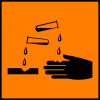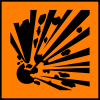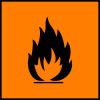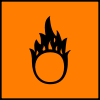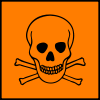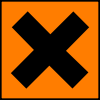- Dangerous goods
-
"Hazmat" redirects here. For the Marvel character, see Hazmat (comics).
Dangerous goods are solids, liquids, or gases that can harm people, other living organisms, property, or the environment. They are often subject to chemical regulations. "HazMat teams" are personnel specially trained to handle dangerous goods. Dangerous goods include materials that are radioactive, flammable, explosive, corrosive, oxidizing, asphyxiating, biohazardous, toxic, pathogenic, or allergenic. Also included are physical conditions such as compressed gases and liquids or hot materials, including all goods containing such materials or chemicals, or may have other characteristics that render them hazardous in specific circumstances.
Dangerous goods are often indicated by diamond-shaped signage. The colours of each diamond in a way has reference to its hazard i.e.: Flammable = red because fire and heat are generally of red colour, Explosive = orange, because mixing red (flammable) with yellow (oxidising agent) creates orange. Non Flammable Non Toxic Gas = green, due to all compressed air vessels being this colour in France after World War II. France is where the diamond system of HazMat identification originated.
Mitigating the risks associated with hazardous materials may require the application of safety precautions during their transport, use, storage and disposal. Most countries regulate hazardous materials by law, and they are subject to several international treaties as well. Even so, different countries may use different class diamonds for the same product. For example, in Australia, Anhydrous Ammonia UN 1005 is classified as 2.3 (Toxic Gas) with sub risk 8 (Corrosive), where as in the U.S. it is only classified as 2.2 (Non Flammable Gas).
People who handle dangerous goods will often wear protective equipment, and metropolitan fire departments often have a response team specifically trained to deal with accidents and spills. Persons who may come into contact with dangerous goods as part of their work are also often subject to monitoring or health surveillance to ensure that their exposure does not exceed occupational exposure limits.
Laws and regulations on the use and handling of hazardous materials may differ depending on the activity and status of the material. For example, one set of requirements may apply to their use in the workplace while a different set of requirements may apply to spill response, sale for consumer use, or transportation. Most countries regulate some aspect of hazardous materials.
The most widely applied regulatory scheme is that for the transportation of dangerous goods. The United Nations Economic and Social Council issues the UN Recommendations on the Transport of Dangerous Goods, which form the basis for most regional and national regulatory schemes. For instance, the International Civil Aviation Organization has developed regulations for air transport of hazardous materials that are based upon the UN Model but modified to accommodate unique aspects of air transport. Individual airline and governmental requirements are incorporated with this by the International Air Transport Association to produce the widely used IATA Dangerous Goods Regulations (DGR)[1]. Similarly, the International Maritime Organization has developed the International Maritime Dangerous Goods Code ("IMDG Code", part of the International Convention for the Safety of Life at Sea) for transportation on the high seas, and the Intergovernmental Organisation for International Carriage by Rail has developed the Regulations concerning the International Carriage of Dangerous Goods by Rail ("RID", part of the Convention concerning International Carriage by Rail). Many individual nations have also structured their dangerous goods transportation regulations to harmonize with the UN Model in organization as well as in specific requirements.
The Globally Harmonized System of Classification and Labeling of Chemicals (GHS) is an internationally agreed upon system set to replace the various different classification and labeling standards used in different countries. GHS will use consistent criteria for classification and labeling on a global level.
Dangerous goods are divided into classes on the basis of the specific chemical characteristics producing the risk.
Note: The graphics and text in this article representing the dangerous goods safety marks are derived from the United Nations-based system of identifying dangerous goods. Not all countries use precisely the same graphics (label, placard and/or text information) in their national regulations. Some use graphic symbols, but without English wording or with similar wording in their national language. Refer to the Dangerous Goods Transportation Regulations of the country of interest.
For example, see the Dangerous Goods Safety Marks[2] in the Canadian Transportation of Dangerous Goods Regulations.
The statement above applies equally to all the Dangerous Goods classes discussed in this article.
Contents
Classification and labeling summary tables
Class 1: Explosives Information on this graphic changes depending on which, "Division" of explosive is shipped. Explosive Dangerous Goods have compatibility group letters assigned to facilitate segregation during transport. The letters used range from A to S excluding the letters I, M, O, P, Q and R. The example above shows an explosive with a compatibility group "A" (shown as 1.1A). The actual letter shown would depend on the specific properties of the substance being transported. For example, the Canadian Transportation of Dangerous Goods Regulations provides a description of compatibility groups.
- 1.1 Explosives with a mass explosion hazard
- 1.2 Explosives with a severe projection hazard.
- 1.3 Explosives with a fire, blast or projection hazard but not a mass explosion hazard.
- 1.4 Minor fire or projection hazard (includes ammunition and most consumer fireworks).
- 1.5 An insensitive substance with a mass explosion hazard (explosion similar to 1.1)
- 1.6 Extremely insensitive articles.
The United States Department of Transportation (DOT) regulates hazmat transportation within the territory of the US.
- 1.1 — Explosives with a mass explosion hazard. (nitroglycerin/dynamite)
- 1.2 — Explosives with a blast/projection hazard.
- 1.3 — Explosives with a minor blast hazard. (rocket propellant, display fireworks)
- 1.4 — Explosives with a major fire hazard. (consumer fireworks, ammunition)
- 1.5 — Blasting agents.
- 1.6 — Extremely insensitive explosives.
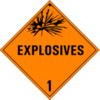
Hazardous Materials Class 1: Explosives 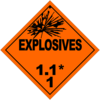
Hazardous Materials Class 1.1: Explosives
Mass Explosion Hazard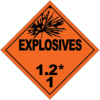
Hazardous Materials Class 1.2: Explosives
Blast/Projection Hazard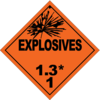
Hazardous Materials Class 1.3: Explosives
Minor Blast Hazard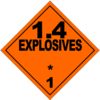
Hazardous Materials Class 1.4: Explosives
Major Fire Hazard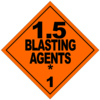
Hazardous Materials Class 1.5: Blasting Agents
Blasting Agents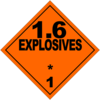
Hazardous Materials Class 1.6: Explosives
Extremely Insensitive ExplosivesClass 2: Gases Gases which are compressed, liquefied or dissolved under pressure as detailed below. Some gases have subsidiary risk classes; poisonous or corrosive. - 2.1 Flammable Gas: Gases which ignite on contact with an ignition source, such as acetylene and hydrogen.
- 2.2 Non-Flammable Gases: Gases which are neither flammable nor poisonous. Includes the cryogenic gases/liquids (temperatures of below -100°C) used for cryopreservation and rocket fuels, such as nitrogen and neon.
- 2.3 Poisonous Gases: Gases liable to cause death or serious injury to human health if inhaled; examples are fluorine, chlorine, and hydrogen cyanide.
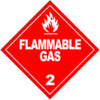
Hazardous Materials Class 2.1: Flammable Gas 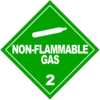
Hazardous Materials Class 2.2: Nonflammable Gas 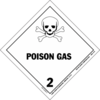
Hazardous Materials Class 2.3: Poisonous Gas 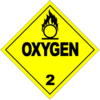
Hazardous Materials Class 2.2: Oxygen (Alternative Placard) 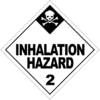
Hazardous Materials Class 2.3: Inhalation Hazard (Alternative Placard) Class 3: Flammable Liquids Flammable liquids included in Class 3 are included in one of the following packing groups: - Packing Group I, if they have an initial boiling point of 35°C or less at an absolute pressure of 101.3 kPa and any flash point, such as diethyl ether or carbon disulfide;
- Packing Group II, if they have an initial boiling point greater than 35°C at an absolute pressure of 101.3 kPa and a flash point less than 23°C, such as gasoline (petrol) and acetone; or
- Packing Group III, if the criteria for inclusion in Packing Group I or II are not met, such as kerosene and diesel.
Note: For further details, check the Dangerous Goods Transportation Regulations of the country of interest.
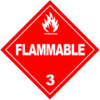
Hazardous Materials Class 3: Flammable Liquids 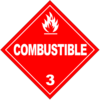
Hazardous Materials Class 3: Combustible (Alternate Placard) 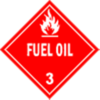
Hazardous Materials Class 3: Fuel Oil (Alternate Placard) 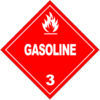
Hazardous Materials Class 3: Gasoline (Alternate Placard) Class 4: Flammable Solids 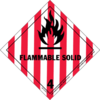
Hazardous Materials Class 4.1: Flammable Solids
4.1 Flammable Solids: Solid substances that are easily ignited and readily combustible (nitrocellulose, magnesium, safety or strike-anywhere matches).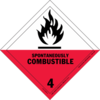
Hazardous Materials Class 4.2: Spontaneously Combustible Solids
4.2 Spontaneously Combustible: Solid substances that ignite spontaneously (aluminium alkyls, white phosphorus).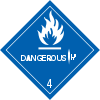
Hazardous Materials Class 4.3: Dangerous when Wet
4.3 Dangerous when Wet: Solid substances that emit a flammable gas when wet or react violently with water (sodium, calcium, potassium, calcium carbide).Class 5: Oxidizing Agents and Organic Peroxides 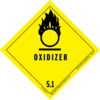
Hazardous Materials Class 5.1: Oxidizing Agent
5.1 Oxidizing agents other than organic peroxides (calcium hypochlorite, ammonium nitrate, hydrogen peroxide, potassium permanganate).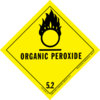
Hazardous Materials Class 5.2: Organic Peroxide Oxidizing Agent
5.2 Organic peroxides, either in liquid or solid form (benzoyl peroxides, cumene hydroperoxide).Class 6: Toxic and Infectious Substances 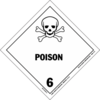
Hazardous Materials Class 6.1: Poison - 6.1a Toxic substances which are liable to cause death or serious injury to human health if inhaled, swallowed or by skin absorption (potassium cyanide, mercuric chloride).
- 6.1b (Now PGIII) Toxic substances which are harmful to human health (N.B this symbol is no longer authorized by the United Nations) (pesticides, methylene chloride).
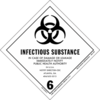
Hazardous Materials Class 6.2: Biohazard - 6.2 Biohazardous substances; the World Health Organization (WHO) divides this class into two categories: Category A: Infectious; and Category B: Samples (virus cultures, pathology specimens, used intravenous needles).
Class 7: Radioactive Substances Class 8: Corrosive Substances Class 9: Miscellaneous 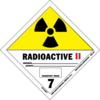
Hazardous Materials Class 7: Radioactive
Radioactive substances comprise substances or a combination of substances which emit ionizing radiation (uranium, plutonium).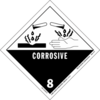
Hazardous Materials Class 8: Corrosive
Corrosive substances are substances that can dissolve organic tissue or severely corrode certain metals:- 8.1 Acids: sulfuric acid, hydrochloric acid
- 8.2 Alkalis: potassium hydroxide, sodium hydroxide

Hazardous Materials Class 9: Miscellaneous
Hazardous substances that do not fall into the other categories (asbestos, air-bag inflators, self inflating life rafts, dry ice).Other hazardous materials labels (CHIP)
Australia
The Australian Dangerous Goods Code, seventh edition (2008) complies with international standards of importation and exportation of dangerous goods in line with the UN Recommendations on the Transport of Dangerous Goods. Australia uses the standard international UN numbers with a few slightly different signs on the back, front and sides of vehicles carrying hazardous substances. The country uses the same "Hazchem" code system as the UK to provide advisory information to emergency services personnel in the event of an emergency.
Canada
Transportation of dangerous goods (hazardous materials) in Canada by road is normally a provincial jurisdiction. The federal government has jurisdiction over air, most marine, and most rail transport. The federal government acting centrally created the federal transportation of dangerous goods act and regulations, which provinces adopted in whole or in part via provincial transportation of dangerous goods legislation. The result is that all provinces use the federal regulations as their standard within their province; some small variances can exist because of provincial legislation. Creation of the federal regulations was coordinated by Transport Canada. Hazard classifications are based upon the UN Model.
The province of Nova Scotia's dangerous goods transportation act can be viewed here: Dangerous Goods Transportation Act
The province of Nova Scotia's dangerous goods transportation regulations can can be viewed here: Dangerous Goods Transportation Regulations
The federal government's Transport Dangerous Goods website is located here: Transportation of Dangerous Goods
Outside of federal facilities, labour standards are generally under the jurisdiction of individual provinces and territories. However, communication about hazardous materials in the workplace has been standardized across the country through Health Canada's Workplace Hazardous Materials Information System (WHMIS).
Europe
The European Union has passed numerous directives and regulations to avoid the dissemination and restrict the usage of hazardous substances, important ones being the Restriction of Hazardous Substances Directive and the REACH regulation. There are also long-standing European treaties such as ADR and RID that regulate the transportation of hazardous materials by road, rail, river and inland waterways, following the guide of the UN Model Regulation.
European law distinguishes clearly between the law of dangerous goods and the law of hazardous materials. The first refers primarily to the transport of the respective goods including the interim storage, if caused by the transport. The latter describes the requirements of storage (including warehousing) and usage of hazardous materials. This distinction is important, because different directives and orders of European law are applied.
United Kingdom
The United Kingdom (and also Australia, Malaysia, and New Zealand) use the Hazchem warning plate system which carries information on how an emergency service should deal with an incident. The Dangerous Goods Emergency Action Code List (EAC) lists dangerous goods; it is reviewed every two years and is an essential compliance document for all emergency services, local government and for those who may control the planning for, and prevention of, emergencies involving dangerous goods. The latest 2009 version is available from the National Chemical Emergency Centre (NCEC) website[3] and as a book[4].
United States
Due to the increase in the perceived threat of terrorism in the early 21st century after the September 11, 2001 attacks, funding for greater HAZMAT-handling capabilities was increased throughout the United States, recognizing that flammable, poisonous, explosive, or radioactive substances in particular could be used for terrorist attacks.
The United States Department of Transportation (DOT) regulates hazmat transportation within the territory of the US by Title 49 of the Code of Federal Regulations[5].
The U.S. Occupational Safety and Health Administration (OSHA) regulates the handling of hazardous materials in the workplace as well as response to hazardous-materials-related incidents, most notably through Hazardous Waste Operations and Emergency Response (HAZWOPER).[6] regulations found at 29 FR 1910.120.
In 1984 the agencies OSHA, EPA, USCG, NIOSH jointly published the first Hazardous Waste Operations and Emergency Response Guidance Manual[6] which is available for download, or can be purchased from the US Government Printing Office, Pub. 85-115[7].
The Environmental Protection Agency (EPA) regulates hazardous materials as they may impact the community and environment, including specific regulations for environmental cleanup and for handling and disposal of waste hazardous materials.
The Consumer Product Safety Commission regulates hazardous materials that may be used in products sold for household and other consumer uses.
Hazard classes for materials in transport
Following the UN Model, the DOT divides regulated hazardous materials into nine classes, some of which are further subdivided. Hazardous materials in transportation must be placarded and have specified packaging and labelling. Some materials must always be placarded, others may only require placarding in certain circumstances.
Trailers of goods in transport are usually marked with a four digit UN number. This number can be referenced by first responders (firefighters, police officers, and ambulance personnel) who can find information about the material in the Emergency Response Guidebook.
Fixed facilities
Different standards usually apply for handling and marking HAZMATs at fixed facilities, including NFPA 704 diamond markings (a consensus standard often adopted by local governmental jurisdictions), OSHA regulations requiring chemical safety information for employees, and CPSC requirements requiring informative labeling for the public, as well as wearing Hazmat suits when handling hazardous materials.
Packing groups
 Doublewall corrugated fiberboard box with dividers for shipping four bottles of corrosive liquid, UN 4G, certified performance for Packing Group III
Doublewall corrugated fiberboard box with dividers for shipping four bottles of corrosive liquid, UN 4G, certified performance for Packing Group III
Packing groups are used for the purpose of determining the degree of protective packaging required for Dangerous Goods during transportation.
- Group I: great danger, and most protective packaging required. Some combinations of different classes of dangerous goods on the same vehicle or in the same container are forbidden if one of the goods is Group I [8].
- Group II: medium danger
- Group III: least danger among regulated goods, and least protective packaging within the transportation requirement
Transport documents
One of the transport regulations is that, as an assistance during emergency situations, written instructions how to deal in such need to be carried and easily accessible in the driver’s cabin.
A license or permit card for hazmat training must be presented when requested by officials.
Dangerous goods shipments also require a special declaration form prepared by the shipper. Among the information that is generally required includes the shipper's name and address; the consignee's name and address; descriptions of each of the dangerous goods, along with their quantity, classification, and packaging; and emergency contact information. Common formats include the one issued by the International Air Transport Association (IATA) for air shipments and the form by the International Maritime Organization (IMO) for sea cargo.
See also
- Agency for Toxic Substances and Disease Registry (ATSDR)
- Area classification
- Biological hazard
- Certified Hazardous Materials Manager (CHMM)
- Chemical hazard
- CLP Regulation
- Dangerous Goods Safety Advisor
- Directive 67/548/EEC
- Globally Harmonized System of Classification and Labelling of Chemicals (GHS)
- Hazard symbol
- Hazchem
- Highly hazardous chemical
- List of Extremely Hazardous Substances
- List of UN Numbers
- National Chemical Emergency Centre (UK)
- National Fire Protection Association (NFPA) standard 704 (US) (the "fire diamond")
- Packaging and labeling
- Packing Group
- Redundant refrigeration system
- UN Recommendations on the Transport of Dangerous Goods
- Waste oil
References
- ^ "Dangerous Goods Regulations (DGR)". IATA. http://www.iata.org/ps/publications/dgr.
- ^ "Dangerous Goods Safety Marks". Transport Dangerous Goods Regulations. Transport Canada. 28 October 2009. http://www.tc.gc.ca/eng/tdg/clear-part4-476.htm. Retrieved 22 February 2011.
- ^ Dangerous Goods Emergency Action Code List (2009 version), http://the-ncec.com/assets/Resources/2009EAClist-latest.pdf
- ^ Dangerous Goods Emergency Action Code List 2009. The Stationery Office (TSO). 2009. ISBN 0-11-341326-2.
- ^ "49 FR". United States Department of Transportation. http://hazmat.dot.gov/regs/rules.htm.
- ^ a b "Hazardous waste operations and emergency response (HAZWOPER)". Occupational Safety and Health Administration (OSHA). 2006. http://www.osha.gov/pls/oshaweb/owadisp.show_document?p_table=STANDARDS&p_id=9765. Retrieved 17 February 2010.
- ^ DHHS (NIOSH) (October 1985), Occupational Safety and Health Guidance Manual for Hazardous Waste Site Activities, pp. 142, Pub. no. 85-115, http://www.cdc.gov/niosh/85-115.html, retrieved 2011-02-22
- ^ "Land Transport Rule - Dangerous Goods". New Zealand Land Transport Agency. http://www.nzta.govt.nz/resources/rules/dangerous-goods-2005.html#s3cola. Retrieved 21 February 2010.
Further reading
- Shipper's Guide to Loading and Securement of Hazardous Materials/Dangerous Goods in Intermodal Equipment-Highway, Rail and Water, October 1999, Institute of Packaging Professionals
- ASTM D4919-03 Standard Specification for Testing of Hazardous Materials Packagings
External links
United States
- Hazardous Substances Data Bank (HSDB) Comprehensive, peer-reviewed toxicology data for about 5,000 chemicals from the National Library of Medicine
- Hazardous Materials Regulations from U.S. Department of Transportation
- Hazardous Materials Emergency Response Guidebook (ERG, 2004 edition) from U.S. Department of Transportation, Transport Canada, and the Transportation Secretariat of Mexico
- United States Occupational Safety and Health Administration (OSHA) CFR 29, 1910.120
- [1] (CSTI)
- The Council on Safe Transportation of Hazardous Articles[dead link]
- United States Department of Transportation Code of Federal Regulations (CFR) 49
- Dangerous Goods Advisory Council (DGAC)
- NIOSH Pocket Guide to Chemical Hazards
- The International Vessel Operators Hazardous Materials Association (VOHMA)
Canada
- Transportation of Dangerous Goods Regulations from Transport Canada
European Union
- Dangerous Substances from the European Agency for Safety and Health at Work
- Recommendations on the Transport of Dangerous Goods (Model Regulations) from United Nations Economic Commission for Europe (UNECE)
- Globally Harmonized System of Classification and Labelling of Chemicals (GHS) from United Nations Economic Commission for Europe (UNECE)
United Kingdom
- Free Online Hazmat/Hazchem Guide from The National Chemical Emergency Centre (NCEC)
- The Dangerous Goods Emergency Action Code List 2009 (EAC) from National Chemical Emergency Centre (NCEC)
Categories:- Safety
- Hazardous materials
- Chemical safety
Wikimedia Foundation. 2010.


